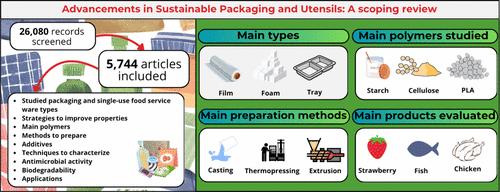Advances in Eco-friendly Materials for Sustainable Packaging and Single-Use Utensils: A Decade of Innovation in Preparation, Characterization, and Applications
IF 8.2
2区 材料科学
Q1 MATERIALS SCIENCE, MULTIDISCIPLINARY
引用次数: 0
Abstract
The demand for sustainable alternatives to synthetic plastics increases, driving research on developing eco-friendly packaging and single-use utensils. Unlike previous reviews, this work provides a critical synthesis of technological trends, identifying gaps that need to be filled and highlighting innovations that are reshaping the field, considering the scientific studies in the past decade. For this, we analyzed 5,744 articles published between 2013 and 2024, selected from 26,080 records retrieved in the Scopus database, through a scoping review aligned with the PRISMA-ScR checklist. Our findings reveal that research has been largely concentrated on films (over 90%), underscoring the need to develop other material types such as foams, cups, straws, and trays. Starch, cellulose, and poly(lactic acid) were the main raw materials with glycerol as the predominant plasticizer. Cross-linkers, fillers, and nanomaterials were incorporated to enhance mechanical, barrier, and functional properties─even though some of them are not biobased nor sustainable. Vegetable extracts and essential oils were used to impart active properties. Evaluations of biodegradability or disintegration, antimicrobial activity, and food preservation applications increased significantly between 2019–2024 compared to 2013–2018, demonstrating a shift toward multifunctional, application-oriented solutions and a growing demand for bioactive packaging. Overall, this review contributes by providing a comprehensive landscape of the field, highlighting the transition toward multifunctional, biodegradable, and innovative packages and utensils while emphasizing the challenges that must be overcome for broader industrial application.

可持续包装和一次性器具的环保材料的进展:制备、表征和应用的十年创新
对合成塑料的可持续替代品的需求增加,推动了开发环保包装和一次性餐具的研究。与以前的评论不同,本工作提供了技术趋势的关键综合,确定了需要填补的空白,并强调了正在重塑该领域的创新,并考虑了过去十年的科学研究。为此,我们分析了2013年至2024年间发表的5,744篇文章,这些文章是从Scopus数据库检索的26,080条记录中挑选出来的,通过与PRISMA-ScR清单一致的范围审查。我们的研究结果表明,研究主要集中在薄膜上(超过90%),强调需要开发其他材料类型,如泡沫、杯子、吸管和托盘。以淀粉、纤维素和聚乳酸为主要原料,甘油为主要增塑剂。交联剂、填料和纳米材料被用于增强机械、屏障和功能性能──尽管其中一些不是生物基的,也不是可持续的。植物提取物和精油被用来赋予活性。与2013-2018年相比,2019-2024年期间对生物降解性或崩解性、抗菌活性和食品保鲜应用的评估显著增加,表明了向多功能、面向应用的解决方案的转变,以及对生物活性包装的需求不断增长。总的来说,这篇综述提供了一个全面的领域景观,强调了向多功能、可生物降解和创新包装和器具的过渡,同时强调了必须克服的挑战,以实现更广泛的工业应用。
本文章由计算机程序翻译,如有差异,请以英文原文为准。
求助全文
约1分钟内获得全文
求助全文
来源期刊

ACS Applied Materials & Interfaces
工程技术-材料科学:综合
CiteScore
16.00
自引率
6.30%
发文量
4978
审稿时长
1.8 months
期刊介绍:
ACS Applied Materials & Interfaces is a leading interdisciplinary journal that brings together chemists, engineers, physicists, and biologists to explore the development and utilization of newly-discovered materials and interfacial processes for specific applications. Our journal has experienced remarkable growth since its establishment in 2009, both in terms of the number of articles published and the impact of the research showcased. We are proud to foster a truly global community, with the majority of published articles originating from outside the United States, reflecting the rapid growth of applied research worldwide.
 求助内容:
求助内容: 应助结果提醒方式:
应助结果提醒方式:


